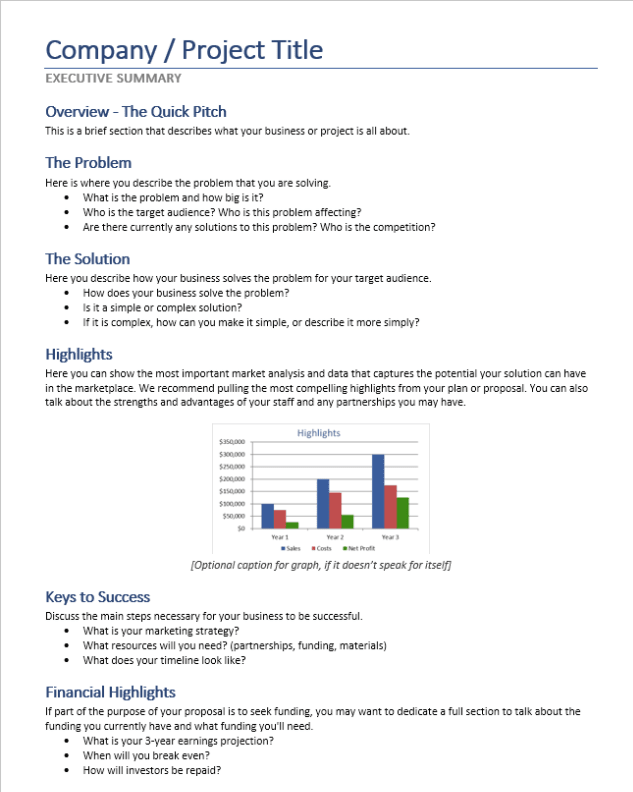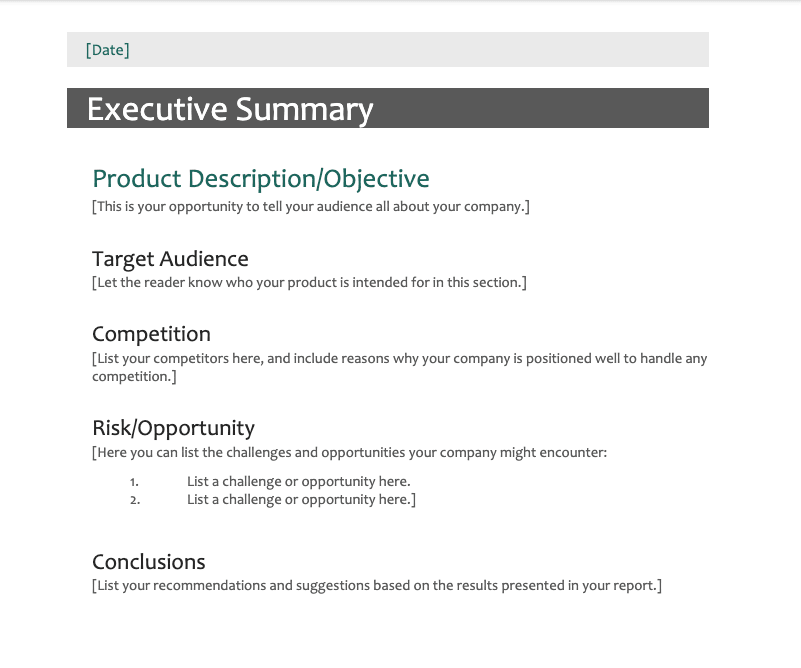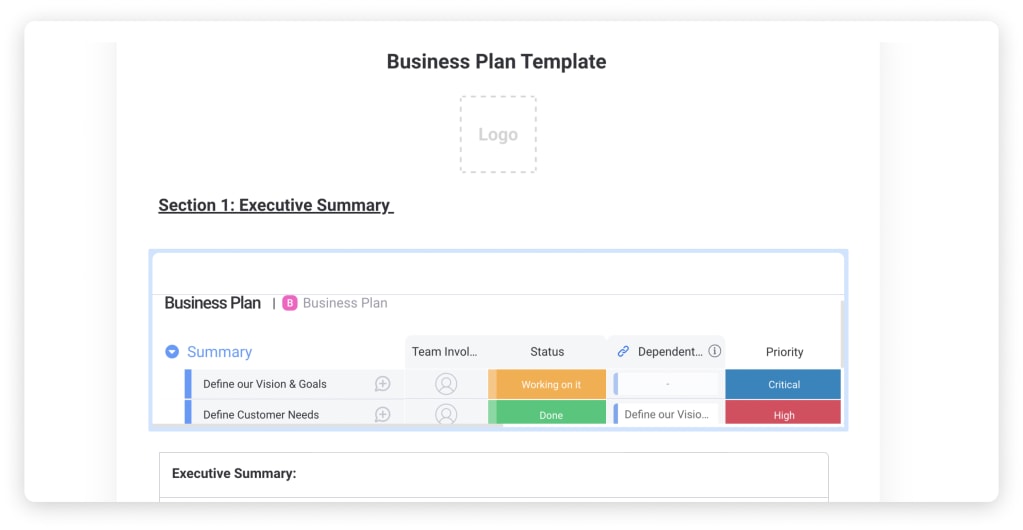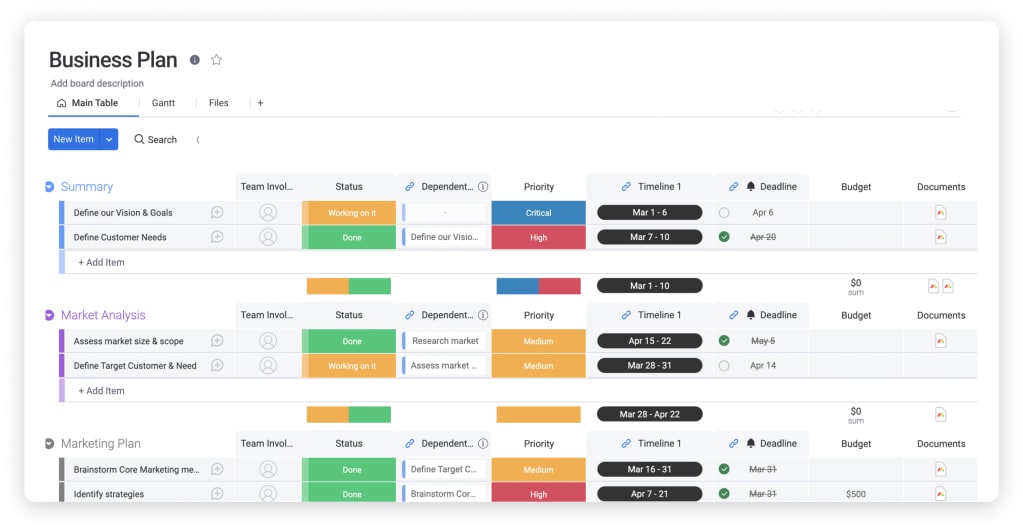Pitching a business idea to an investor is enough to break down even the most prepared entrepreneurs. If you’re scrambling to get your value proposition across while fighting the clock, your business plan can quickly fall apart — along with your confidence.
It doesn’t have to be that way, though. You can write a great business plan and deliver it — almost — without breaking a sweat. The key to success is summarizing your thoughts in a concise summary. In this article, you’ll learn how to grab your stakeholders’ attention and deliver all the key information with an effective executive summary template.
What is a business executive summary template?
A business executive summary template is a framework for highlighting the core points of your business plan with your target audience in mind. In the template, you’ll have space to fill out all information that pertains to the management of your business. This can include sales and marketing strategies, figures related to the staff and other expenses, and short and long-term objectives.
The business executive summary is usually written after the full business plan has been developed, and its aim is to fill investors in on your business proposition. It’s a brief text that emphasizes what your business is, who it can serve, and why it’s worth investing in.One way to think of the summary is as an elevator pitch that seeks to convey as much information as possible in the shortest time.
Why use a business executive summary template?
With the business executive summary template, all you have to do is distill down the essential parts of your business plan into easy-to-digest words. Bullet point lists and short sentences can help get across the most important information in a way that’s brief and scannable.
You can use the business executive summary template as a guide for boiling down the basics of your company for potential investors. Without a summary template, you may neglect to mention significant aspects of your business that could detrimentally affect your pitch. The last thing you want is to create an executive summary that’s long-winded and padded out with irrelevant data.
Give investors a pitch to remember by creating a hard-hitting executive summary that’s granular yet concise — which you can use a template to do. Often, this approach will yield better results than the long-winded approach since you condense the information down into a palatable presentation.
It also ensures that you use a consistent format each time you create a new one, which makes them skimmable for busy investors and high-level executives — in fact, investors have little time to read pitch decks, with an average time spent of 3 minutes and 44 seconds. This evidence suggests that investors don’t have time for reading the entire document, so you only have a few minutes to get your message across.
A business executive summary template can also streamline your pitching process. If you have meetings with various investors, you can plug in and swap out information according to the individuals you’re pitching to. The dawn of a new year can bring the promise of fresh investment, yet the reality is that as of February 2022, investor activity has declined by 5.56%.
What are some examples of business executive summary templates?
Let’s look at a few business executive summary template examples.
Problem resolution
Highlight the customer pain point you’re looking to address with your business, and you’ll quickly capture the interest of your audience.

A business idea that doesn’t solve an obvious problem can be left by the wayside if investors don’t see the potential financial gain. Customers should have a compelling reason to buy the product or service, and if you can’t prove that you have one, investors won’t have a reason to invest.
Risk and opportunity analysis
With the risk and opportunity analysis, you can show off your knowledge of your target market and where your business fits in. Demonstrate to investors that you’ve carried out the research and prove that the opportunity is there for the taking.

When you show an understanding of your target audience and what the competition offers, you give the investor an overview of what risks they’ll assume and what they could gain.
Action plan summary
When evaluating business pitches, investors generally appreciate a clear roadmap for the business’s long-term success. Highlight the route to market, including your market strategy, and indicate any obstacles you’ll face to demonstrate that you’ve thought it through.

When you present a bulleted list of next steps or actions for your management team to take, you prove to investors that you’re forward-thinking and can elevate your business with financial backing. Investors ultimately want to know where their money will be going, so they’ll want to see that information when they read your executive summary.
monday.com’s business executive summary template
Use monday.com business executive summary template to take the core information from your business plan and break it down into bite-sized takeaways for investors. Our template gives you something to work from by giving you a space to create a central knowledge base. When it comes time to draw up your executive summary, you just need to enter the information and change it according to who you’re pitching to.

monday.com Work OS real-time tracking and analytics can help you reinforce every point you make in your summary with data. That way, you can show off your understanding of the current state of the market as well as future trends.
monday.com workdocs can be another useful tool to aid your quest for investment, as you can pass your summary around and receive valuable feedback. With monday.com workdocs, it’s easy to collaborate on business documents, share comments, and ultimately promote teamwork. Since it’s important to get the summary right, you want as many people to see it as possible so you can present an airtight pitch to investors.

Business executive summary template tips and tricks
Here are a few tips to keep in mind when using a business executive summary template.
1. Carry out a market analysis
If you want to create an effective business plan executive summary, it’s best to start with a thorough market analysis. If you can sprinkle relevant statistics and figures into your summary, there’s a greater chance it’ll do a better job of convincing investors to part with their cash.
Without market research to back up your claims, investors won’t have any real data to latch onto. If you were to pitch a brick-and-mortar business a few months into the pandemic in 2020, you’d likely be laughed out of the boardroom.
If you show investors that you have your finger on the pulse of market trends, they’ll listen up.
2. Use financial projections
Think about where your business could fit into the market, not only today but several months and even years from now. Consider the market share you could conceivably reach and what your figures might be based on your closest competition.
Financial projections are critical to the success of any pitch. The bottom line is investors want to make money, so they’re not likely to invest in a business that will operate at a loss.
3. Remember that it’s a summary, not a plan
The business executive summary is called such because it should be drawn up after you’ve created a detailed business plan. If you were to try and create it before making your business plan, you may leave out important information that could prove costly.
FAQs about business executive summary templates
Let’s go over the answers to some common questions about business executive summary templates.
What does an executive business summary include?
An executive business summary should include all of the following information:
- Financial information and projections
- Route to market
- Sales and marketing strategy
- Business goals and objectives
- Competitor analysis
- Allocation of funds
- Next steps to ensure your business comes to fruition
How do you write an executive summary for a business plan?
To write an executive summary, you need to take all the most important information from your business plan and present it clearly. A good way to approach the summary is to assume that it will be the only text the investors will read. This is often a reality, as investors safeguard their time and receive many pitches throughout the day. With that in mind, you want the summary to contain everything investors need to know without having to read the rest, according to the elements laid out in the template.
How long should an executive summary be?
Ideally, an executive summary should capture the investors’ attention and deliver all the key points in the space of a few minutes. The shorter, the better, but as a general goal, it’s wise to aim for two pages maximum, or 10% of your entire business plan.
